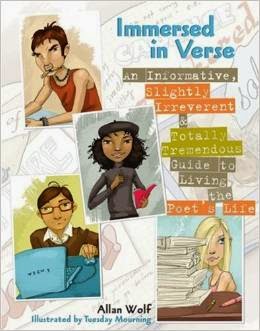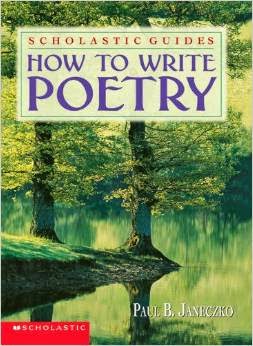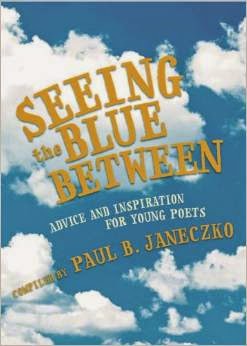On this last day of the month I thought I would wrap up this year's National Poetry Month project by highlighting books that focus on form and the writing of poetry.
When I was in high school I wrote free verse, largely because that's all I knew. While I recall writing the occasional haiku as a English assignment, I was never instructed on how to write poetry. Oh, how I wish I had been! Poetry can be so much fun to play and puzzle with. Trying to make your ideas and favorite words fit into a structured form can be a daunting task, but one that gives much satisfaction upon its completion.
Today I rely on a varied collection of books while writing poetry. In addition to the "adult" books on poetry reading and writing, I often turn to books for children and young adults to help me think about form and process. Here are some of the books I use with regularity.
When I was in high school I wrote free verse, largely because that's all I knew. While I recall writing the occasional haiku as a English assignment, I was never instructed on how to write poetry. Oh, how I wish I had been! Poetry can be so much fun to play and puzzle with. Trying to make your ideas and favorite words fit into a structured form can be a daunting task, but one that gives much satisfaction upon its completion.
Today I rely on a varied collection of books while writing poetry. In addition to the "adult" books on poetry reading and writing, I often turn to books for children and young adults to help me think about form and process. Here are some of the books I use with regularity.
A Kick in the Head: An Everyday Guide to Poetic Forms (2005), compiled by Paul B. Janeczko and illustrated by Chris Raschka, begins with an introduction about poetic forms. It reads:
Why, you may ask, do poems have rules? Why 17 syllables in a haiku? Why 14 lines in a sonnet? The answer is: rules make the writing of a poem more challenging, more exciting. Think of a game you enjoy, like baseball. Imagine how much less intriguing the game would be if there were no foul line or limit to the number of outs in an inning. The rules often ask, "Can you do a good job within these limits?" Knowing the rules makes poetry—like sports—more fun, for players and spectators alike.What follows are 29 poetics forms. Each form is accompanied by some kind of visual clue in the top corner of the page. For example, the page for couplet shows two birds on a wire, epitaph shows a headstone, and ode shows a Grecian urn. Once the form has been identified, readers find a short informational description and poetic example. Here's what you'll find on the page for Riddle Poem.
The beginning of eternity
The end of time and space,
The beginning of every end,
The end of every place.
Anonymous
A riddle poem indirectly describes a person, place, thing, or idea. The reader must try to figure out the subject of the riddle. A riddle poem can be any length and usually has a rhyme scheme of abcb or aabb.This volume not only contains many familiar forms, such as haiku, cinquain, acrostic and limerick, but also forms such as aubade, pantoum, villanelle, and double dactyl. At the end of the book readers will find a bit more background information on each of the 29 forms.
Getting From Here To There: Writing and Reading Poetry (1982, OP), written by Florence Grossman, is a book I pulled out of a discard pile years ago, but one that I still crack open. If you can find a copy, it is an informative volume to have. Here is how it begins.
Most people have never written poetry, yet most people, at one time or another, have had the vague sense of a poem lurking somewhere, something they had experienced that had to be told in a special way. This book is addressed to you if you have ever wanted to write a poem and did not know the place to begin, or if you have not trusted yourself because you thought you did not know the language of poetry.
... And rhyme? Most beginning writers are boxed in by rhyme because they're busy thinking about the word that will rhyme instead of allowing words and ideas to bounce off each other. For now, forget about rhyme. Focus on rhythm. When you begin to listen to yourself, the poem will find its own rhythm. It will find its own length. Once you get rolling, the poem will assume a life of its own. It will tell you what it has to say.The book is organized into the following chapters: (1) Lists; (2) Then; (3) Things; (4) Signs; (5) Image; (6) People; (7) Clothes, etc.; (8) Sound/Silence; (9) Persona; and (10) Dreams and Fantasies. What I love is that in the introduction to each chapter, Grossman gives readers a perspective and an insight into writing poetry that is often profound. Here is an example from the chapter "Things."
Paper clips, rubber bands, a book of matches, these small things that go about daily business of their lives—most people would never think of them as subjects of poetry. But as walls have ears and pillows have secrets, each of these things has its own story. It has been places and done things. For the poet it's a matter of tuning in, of holding the spool of thread until we have heard what it has to say. Look long enough at a pencil and the poem will begin.In addition to these insights, each chapter contains numerous example poems, thought prompts, and writing suggestions. The text ends with a section entitled Some Notes on Self Editing. There are 10 bulleted items here that are pithy and helpful. Here are a few.
- What we are after here is honesty.
- We all have our own words, words that we've carried around with us for years, words that we've tried on and we're comfortable with. These are the words of "our voice" that tell the reader someone has written this poem. Be true to those words.
- Honest also means the exact word rather than the well-that-will-do word. Poetry is concise—no time to fool around with approximations. "The best words," says Wallace Stevens, "in their best order."
A Crow Doesn't Need A Shadow: A Guide to Writing Poetry From Nature (1994), written by Lorraine Ferra with illustrations by Diane Boardman, focuses on the "integration of our inner and outer landscapes. Through nature field trips, children and adults are invited to reflect on their personal place in the world." Sections of the book include: (1) Poetry Field Trips; (2) Building a Nature Wordscape; (3) Keeping a Nature Journal; (4) Other Explorations (which includes such topics as finding a companion in nature, creating a landscape, colors in the natural world, dreaming up a place, nature in your hand, and more); (5) Anthology--a sampling of original poems by young authors; and (6) A Note To Educators (written by Mona Hirschi Daniels). The book begins this way.
Open the Door
An Invitation to Readers
Over three hundred years ago, the poet Matsuo Basho said, "To learn about a tree, go to a tree." Basho was considering more than the scientific facts you learn about trees. He was suggesting that the creatures of the natural world speak a language, one perhaps different from yours, but one you can understand if you listen with your imagination.
...Every chapter of this book, every poem, is a different door you can open to the natural world. Choose any of these doors, open it, and step quietly outside with your pencil, paper, and imagination.
In the section Creating a Landscape, Ferra shares a recipe poem by a twelve year old boy and guides readers through the process of writing their own. Here's an excerpt.
Look through a cookbook. As you read the directions for several different recipes, write down the verbs which tell you what to do with the ingredients. Make a list of about ten or twelve different verbs. Keep in mind that you probably won't use all the verbs you find. Be selective for your poem.
Some possible subjects might be a recipe for a cave, foggy morning, a bird refuge, a season or particular month, a moonlit field, a river, or a sunset. Once you decide on your subject, start listing some ingredients.
While there is no emphasis here on form, this is wonderful book for encouraging close observation, a skill so vital to the poet's craft.
Leap Into Poetry: More ABCs of Poetry (2001), written and illustrated by Avis Harley, is a companion to FLY WITH POETRY that uses the alphabetic format to introduce a variety of poetic forms and techniques. Each letter introduces an arthropod in a poem that uses the stated form or technique. Facts about each animal are included in the end notes.
Write Your Own Poetry (2008), written by Laura Purdie Salas, is a book that provides a thorough introduction to the process and tools of writing poetry. There are chapters on poetic forms, language of poetry, imagery, point of view, meter and rhyme, and more. Jam-packed with sample poems, helpful tips and advice from poets, this is a comprehensive introduction to writing poetry.
Have you noticed how rhythm makes you move? How heave bass vibrates the door panels of passing cars? Have you noticed the colors of a rainbow? How the stench of fireworks burns your eyes? How you cold winter hands sting under warm water? To be a poet is to notice.The book is divided into several sections, each color-coded for ease of use. Poetry & You offers readers a quick guided tour of poetry, nine habits of successful poets (such as get gonzo over words, write every day and play), a writing pledge and more you. Your Poetry Toolbox explains the tools of the trade, such as poetic devices and the anatomy of a poem. The Poet's Decisions delves deep into the process of writing, providing lessons on point of view, tense, form, playing with structure, revising and much more. Always Something to Write About provides ideas for journaling and writing prompts. The last major section, Ta Da!: Presenting Your Work is about reading, performing and publishing poetry. Liberally sprinkled throughout the text are examples and lots of poems from a range of poets.
...
Poems are all around us, waiting to be written. The world teems with words, images, ideas, sights, sounds, colors, anecdotes, notions, and emotions. Just as water is the stuff of life to a fish, the world is the stuff of life to be a poet. all you need to do is dive in.
One of my favorite sections is entitled Your Best Revising Tools. Having just spent a significant amount of time revising a poem, I can tell you how much these ring true. Here they are in abbreviated form.
- Time - It's very difficult to read a poem objectively on the day you wrote it. It's best to let it age—a day, a week, a month.
- An Audition - With poetry, there's no room for words that aren't pulling their weight. Make those words work for you. Make them prove they belong where they are.
- A Sense of Fearless Tinkering - Don't be afraid to take apart what you've done. . . . Take your poem apart and put it back together. Don't worry about the extra parts still on the floor.
- Highlighting the Poem's Golden Moments - Use a yellow highlighter to designate your poem's top three golden moments (be they a single work, a partial phrase, or an entire line) that are vital to the poem's life. . . . Once you've highlighted the poem's golden moments, examine the remaining words with a critical eye.
- Vivacious Vocal Cords - Poetry is ultimately a spoken art. . . . but it's also a great revision tool. It helps flag a poem's awkward phrases, blips, bleeps, and blemishes.
The book ends with appendices of selected poems and poets, as well as publishing resources for young writers.
How to Write Poetry (1999), written by Paul Janeczko, is a Scholastic Guide that organizes the poetry writing process into easy-to-follow steps. The chapters on starting to write, writing poems that rhyme, and writing free verse poems all offer a wealth of information, sample poems, and "try this" suggestions. Different poetic forms are introduced along with checklists to keep writers focused on important features. Includes an extensive glossary.
Poetry from A to Z: A Guide for Young Writers (1994), written by Paul Janeczko, is a collection of 72 poems arranged alphabetically by subject. Also included are 14 poetry-writing exercises that show how to write specific types of poems and advice from more than twenty poets on becoming a better writer.
Poetry Matters: Writing a Poem From the Inside Out (2002), written by Ralph Fletcher, is a good guide to writing poetry from the heart. Chapters deal with imagery, rhythm, crafting poems, wordplay, and more. Major poetic forms are defined and there is a section on ways to share your work. Interviews with Kristine O'Connell George, Janet Wong, and J. Patrick Lewis are included. A number of poems written by Fletcher are included as examples in these chapters.
Poetry from A to Z: A Guide for Young Writers (1994), written by Paul Janeczko, is a collection of 72 poems arranged alphabetically by subject. Also included are 14 poetry-writing exercises that show how to write specific types of poems and advice from more than twenty poets on becoming a better writer.
Poetry Matters: Writing a Poem From the Inside Out (2002), written by Ralph Fletcher, is a good guide to writing poetry from the heart. Chapters deal with imagery, rhythm, crafting poems, wordplay, and more. Major poetic forms are defined and there is a section on ways to share your work. Interviews with Kristine O'Connell George, Janet Wong, and J. Patrick Lewis are included. A number of poems written by Fletcher are included as examples in these chapters.
Seeing the Blue Between: Advice and Inspiration for New Poets (2002), compiled by Paul Janeczko, contains a collection of letters and poems by children's poets. Written to and for aspiring writers, this volume provides advice and inspiration.
The Place My Words Are Looking For: What Poets Say About and Through Their Work (1990), selected by Paul Janeczko, is a collection of poems, advice, anecdotes, and recollections of 39 poets. Following their poems, poets describe their inspirations, memories, where they get their ideas, their writing processes, and how they go about translating their ideas into poetic form.
If you are looking for additional resources on poetry writing, try these sites.
April may be ending, but that doesn't mean the poetry goodness must stop. I hope you'll revisit some of the posts from this month as you incorporate more poetry reading and writing in your classroom. You can find a list containing all this month's posts at NPM 2015 Poetic Forms.- Joyce Sidman shares a terrific article everyone should read entitled Touching the World: The Importance of Teaching Poetry.
- Scholastic's Writing with Writers site has a section on poetry. Kids can learn to write with Jack Prelutsky, Karla Kuskin and Jean Marzollo.
- Kenn Nesbitt's Poetry4Kids site has a section of poetry lessons for kids.
- ReadWriteThink has a nice set of tips on how to Help a Child Write a Poem.
- Elaine at Wild Rose Reader has a two part series on Recipe & How to Make ... Poems. Check out Part 1 and Part 2.
- You can view a range of kids poetry in a variety of forms at Magnificent Rainbow: Kids Form Poems.
- Giggle Poetry has a poetry class section with lots of lessons on writing poetry.
- PBSKids has a site called Fern's Poetry Nook, where kids can learn more about writing a poem.
- Poet Marilyn Singer has ten tips for writing poetry.
- Poet Joyce Sidman has a page with all sorts of poetry ideas to get you started.
- Poet Kristine O'Connell George has a poetry power page with a wealth of resources on writing poetry. She also has a terrific page with tips for poets on observation.
Thanks to everyone who has stopped by this month. It has been a joy sharing poetry with you.












Love, love, love this post. I'll be back for a careful reading. But a quick scan shows many titles I already know and love and a few new-to-me and need-to-request titles. I can't wait to share this with friends and include a link on my blog!
ReplyDeleteThank you, Ramona! As I was writing I realized I had to leave many books off the list, so I will probably be back with a part 2.
DeleteThank you very much sharing these titles (as well as all the great content you featured for National Poetry Month), Tricia! PBJ's books are some of my all-time favorites.
ReplyDeleteWhat a fabulous resource, Tricia! Woohoo!
ReplyDelete